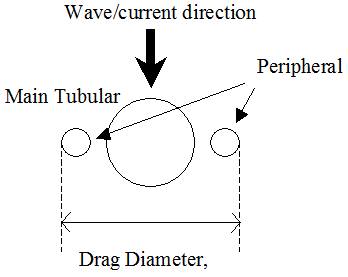The mass density calculations are based on first computing a figure for the total mass of each joint, including main tubular, peripherals and buoyancy material if present.
The calculation of equivalent drag diameter depends on whether buoyancy material is attached to a joint or not. For the bare joints, the calculation is based on the below figure. For these joints, Dd is input as (21” + 2*5”) = 31”, on the basis that this is the most conservative combination of main tubular OD and peripheral OD. For the buoyed joints, the drag diameter is simply specified as the buoyancy module OD of 47”.

Drag Diameter Definition
The buoyancy diameter calculations are based on first computing a figure for the total volume of water displaced by each joint, including main tubular, peripherals and buoyancy material if present. An equivalent buoyancy diameter that will give the same volume of displaced water is then calculated for input to Flexcom.